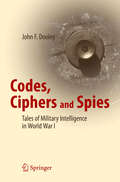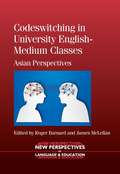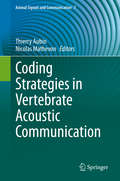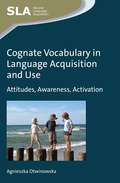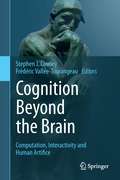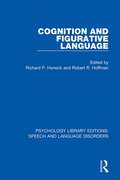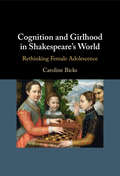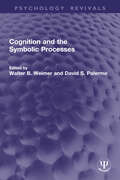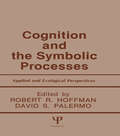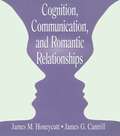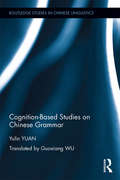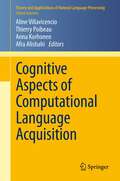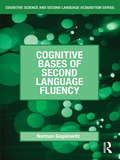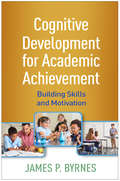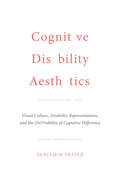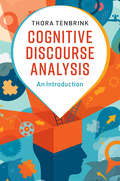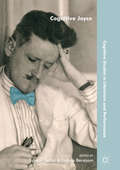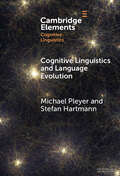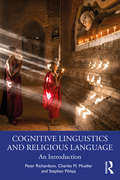- Table View
- List View
Codes, Ciphers and Spies: Tales of Military Intelligence in World War I
by John F. DooleyWhen the United States declared war on Germany in April 1917, it was woefully unprepared to wage a modern war. Whereas their European counterparts already had three years of experience in using code and cipher systems in the war, American cryptologists had to help in the building of a military intelligence unit from scratch. This book relates the personal experiences of one such character, providing a uniquely American perspective on the Great War. It is a story of spies, coded letters, plots to blow up ships and munitions plants, secret inks, arms smuggling, treason, and desperate battlefield messages. Yet it all begins with a college English professor and Chaucer scholar named John Mathews Manly. In 1927, John Manly wrote a series of articles on his service in the Code and Cipher Section (MI-8) of the U. S. Army's Military Intelligence Division (MID) during World War I. Published here for the first time, enhanced with references and annotations for additional context, these articles form the basis of an exciting exploration of American military intelligence and counter-espionage in 1917-1918. Illustrating the thoughts of prisoners of war, draftees, German spies, and ordinary Americans with secrets to hide, the messages deciphered by Manly provide a fascinating insight into the state of mind of a nation at war.
Codes: How to Make Them and Break Them! (Murderous Maths Ser.)
by Ian Baker Kjartan PoskittDid you ever want to send a message that only your friend can read? Or did you want to try and uncover a secret communication from someone else? If so, then here's everything you need to know about creating and cracking codes-from the simplest substitution messages to the secrets of the well-known World War II coding contraption, the amazing Enigma Machine!The book includes information about:Substitution codesScrambling codesCodes containing unrecognizable symbolsOther message systems such as Morse code and flagsAnd how to make your own Enigma machine!You’ll be thrilled as this amusing book takes you on a codebreaking adventure, learning ways to decode both simple and difficult puzzles, as well as provides you with a history on the cryptology. Filled with tips and enjoyable illustrations by Ian Baker, Codes will have you sending secret messages in no time.
Codeswitching in University English-Medium Classes
by Roger Barnard James MclellanIn the complex, multilingual societies of the 21st century, codeswitching is an everyday occurrence, and yet the use of students' first language in the English language classroom has been consistently discouraged by teachers and educational policy-makers. This volume begins by examining current theoretical work on codeswitching and then proceeds to examine the convergence and divergence between university language teachers' beliefs about codeswitching and their classroom practice. Each chapter investigates the extent of, and motivations for, codeswitching in one or two particular contexts, and the interactive and pedagogical functions for which alternative languages are used. Many teachers, and policy-makers, in schools as well as universities, may rethink existing 'English-only' policies in the light of the findings reported in this book.
Coding Literacy: How Computer Programming Is Changing Writing (Software Studies)
by Annette VeeHow the theoretical tools of literacy help us understand programming in its historical, social and conceptual contexts.The message from educators, the tech community, and even politicians is clear: everyone should learn to code. To emphasize the universality and importance of computer programming, promoters of coding for everyone often invoke the concept of “literacy,” drawing parallels between reading and writing code and reading and writing text. In this book, Annette Vee examines the coding-as-literacy analogy and argues that it can be an apt rhetorical frame. The theoretical tools of literacy help us understand programming beyond a technical level, and in its historical, social, and conceptual contexts. Viewing programming from the perspective of literacy and literacy from the perspective of programming, she argues, shifts our understandings of both. Computer programming becomes part of an array of communication skills important in everyday life, and literacy, augmented by programming, becomes more capacious.Vee examines the ways that programming is linked with literacy in coding literacy campaigns, considering the ideologies that accompany this coupling, and she looks at how both writing and programming encode and distribute information. She explores historical parallels between writing and programming, using the evolution of mass textual literacy to shed light on the trajectory of code from military and government infrastructure to large-scale businesses to personal use. Writing and coding were institutionalized, domesticated, and then established as a basis for literacy. Just as societies demonstrated a “literate mentality” regardless of the literate status of individuals, Vee argues, a “computational mentality” is now emerging even though coding is still a specialized skill.
Coding Strategies in Vertebrate Acoustic Communication (Animal Signals and Communication #7)
by Thierry Aubin Nicolas MathevonInformation is a core concept in animal communication: individuals routinely produce, acquire, process and store information, which provides the basis for their social life. This book focuses on how animal acoustic signals code information and how this coding can be shaped by various environmental and social constraints. Taking birds and mammals, including humans, as models, the authors explore such topics as communication strategies for “public” and “private” signaling, static and dynamic signaling, the diversity of coded information and the way information is decoded by the receiver. The book appeals to a wide audience, ranging from bioacousticians, ethologists and ecologists to evolutionary biologists. Intended for students and researchers alike, it promotes the idea that Shannon and Weaver’s Mathematical Theory of Communication still represents a strong framework for understanding all aspects of the communication process, including its dynamic dimensions.
Coffee Stories: Coffee સ્ટોરીઝ: એક સિપ હૂંફાળા સંબંધોને નામ!
by Raam Moriઆપણી સંસ્કૃતિ કથા અને કથનશૈલીની સંસ્કૃતિ રહી છે. કથાઓ આપણી આસપાસ દરેક ક્ષણે જીવાતી જ હોય છે. ધબકતી હૂંફાળી કથાઓ, સમાજના ડરથી સંકોડાયેલી તર નીચે ઠરી ગયેલી કથાઓ, પહેલાં જ ઘૂંટડે કડવી ઝેર લાગતી કથાઓ તો એક એક સિપ સાથે વધુને વધુ ગળચટ્ટી બનતી કથાઓ. નજરની સામે દરરોજ ભજવાતી એવી કથાઓ જે હજુ સુધી આપણા ધ્યાનમાં જ નથી આવી અથવા એવી કથાઓ જે સતત ધ્યાનમાં તો આવી છે પણ આપણે સતત આંખો મીંચી રાખી છે. કથાઓ એવી જેમાં આપણું પોતાનું મૌન ઘૂંટાયેલું રહ્યું છે ને એ મૌનની પરિભાષાને પણ લોકો ઉકેલી જાણે છે તો એવી પણ કથાઓ જેમાં ચિલ્લાઈ ચિલ્લાઈને પીડાને પોકારવામાં આવી હોય એમ છતાં એને સાંભળનાર કોઈ નથી હોતું. દઝાડતી, ફરિયાદ કરી લાલ આંખ કરીને આપણી સામે એકધારું જોઈ રહી છે એવી કથાઓ ખરેખર કોફીના કપ સાથે પુરી થઇ જાય અને કોફીની જેમ મગજ સતેજ કરી દે એવી વાર્તાઓનો સમુહ!
Cognate Vocabulary in Language Acquisition and Use
by Agnieszka OtwinowskaThis book brings together linguistic, psycholinguistic and educational perspectives on the phenomenon of cognate vocabulary across languages. It presents a large-scale, long-term research project focusing on Polish-English cognates and their use by bilingual and multilingual learners/users of English. It discusses extensive qualitative and quantitative data to explain which factors affect a learner's awareness of cognates, how adult learners can benefit from raised awareness and whether cognate vocabulary can be used with younger learners as a motivational strategy. The work shows how cognate vocabulary can be examined from a range of methodological perspectives and provides considerable insights into crosslinguistic influences in language learning. While the focus of the studies is Polish-English cognates, the research will be of interest to anyone teaching learners of different language constellations, levels, ages and backgrounds.
Cognition Beyond the Brain: Computation, Interactivity and Human Artifice
by Stephen J. Cowley Frédéric Vallée-TourangeauCognition Beyond the Brain challenges neurocentrism by advocating a systemic view of cognition based on investigating how action shapes the experience of thinking. The systemic view steers between extended functionalism and enactivism by stressing how living beings connect bodies, technologies, language and culture. Since human thinking depends on a cultural ecology, people connect biologically-based powers with extended systems and, by so doing, they constitute cognitive systems that reach across the skin. Biological interpretation exploits extended functional systems. Illustrating distributed cognition, one set of chapters focus on computer mediated trust, work at a construction site, judgement aggregation and crime scene investigation. Turning to how bodies manufacture skills, the remaining chapters focus on interactivity or sense-saturated coordination. The feeling of doing is crucial to solving maths problems, learning about X rays, finding an invoice number, or launching a warhead in a film. People both participate in extended systems and exert individual responsibility. Brains manufacture a now to which selves are anchored: people can act automatically or, at times, vary habits and choose to author actions. In ontogenesis, a systemic view permits rationality to be seen as gaining mastery over world-side resources. Much evidence and argument thus speaks for reconnecting the study of computation, interactivity and human artifice. Taken together, this can drive a networks revolution that gives due cognitive importance to the perceivable world that lies beyond the brain. Cognition Beyond the Brain is a valuable reference for researchers, practitioners and graduate students within the fields of Computer Science, Psychology, Linguistics and Cognitive Science.
Cognition and Figurative Language (Psychology Library Editions: Speech and Language Disorders)
by Robert R. Hoffman Richard P. HoneckOriginally published in 1980, this is a book about the psychology of figurative language. It is however, eclectic and therefore should be of interest to professionals and students in education, linguistics, philosophy, sociolinguistics, and other concerned with meaning and cognition. The editors felt there was a pressing need to bring together the growing empirical efforts of this topic. In a sense, recognition of the theoretical importance of figurative language symbolized the transition from the psycholinguistics of the 1960s to that of the late 1970s, that is from a linguistic semantics to a more comprehensive psychological semantics with a healthy respect for context, inference, world knowledge, and above all creative imagination. The organization of the volume reflects the more basic, general concerns with cognition – from historical and philosophical background, through problems of mental representation and semantic theory, to developmental trends, and to applications in problem solving.
Cognition and Girlhood in Shakespeare's World: Rethinking Female Adolescence
by Caroline BicksThis groundbreaking study of girlhood and cognition argues that early moderns depicted female puberty as a transformative event that activated girls' brains in dynamic ways. Mining a variety of genres from Shakespearean plays and medical texts to autobiographical writings, Caroline Bicks shows how 'the change of fourteen years' seemed to gift girls with the ability to invent, judge, and remember what others could or would not. Bicks challenges the presumption that early moderns viewed all female cognition as passive or pathological, demonstrating instead that girls' changing adolescent brains were lightning rods for some of the period's most vital debates about the body and soul, faith and salvation, science and nature, and the place and agency of human perception in the midst of it all.
Cognition and the Symbolic Processes (Psychology Revivals)
by David S. Palermo Walter B. WeimerOriginally published in 1974 and taking the revolution in psycholinguistics and cognitive psychology as a point of departure, this book summarizes the lessons learned from past attempts to construct a psychology of the higher mental processes. Even more importantly, it crystallizes specific directives and research proposals that show where cognitive psychology ought to go in the future. The relationship of learning theory, linguistics, and perception to the broad field of cognition and the nature of mind and knowledge are examined in detail. Today it can be read in its historical context.
Cognition and the Symbolic Processes: Applied and Ecological Perspectives
by Robert R. Hoffman David S. PalermoThis volume is a festschrift dedicated to James J. Jenkins, a pioneer in many areas of experimental psychology. It has three major goals: to provide a forum for debate on current theoretical issues in cognitive psychology, to capture the "state of the art" in reviews of research methods and results, and to generate ideas for new research directions and methodologies. Contributors -- including Jenkins' former students and present colleagues -- ponder fundamental questions such as: * How do people learn to read? * What happens during the processes of speech perception? * How do people acquire problem solving skills? * How do cognitive and motor skills develop and integrate with one another? Many chapters focus specifically on ecological and applied cognitive psychology. Specific topics covered include visual and speech perception, language, memory, motivation, child development, problem solving, and pedagogy.
Cognition, Communication, and Romantic Relationships (LEA's Series on Personal Relationships)
by James M. Honeycutt James G. CantrillCognition, Communication, and Romantic Relationships focuses on the role of memory, communication, and social cognition in the development of romantic relationships. The authors review developmental models of communication and examine criticisms of these models. They also explore the stages through which relationships escalate and deteriorate, and consider the processes for such activities as meeting new people, dating, sexual intercourse, and terminating relationships. Differences between men and women are discussed throughout the text, in light of current research supporting systematic gender differences in how people think about romance and relationships. As an extended analysis and research review of how thinking about romance influences and is influenced by communicative processes, this text offers a deeper understanding of the cognitive and communicative factors involved in relationship processes. It is designed for use in courses on interpersonal relationships and intimate relations in social psychology, communication, counseling psychology, clinical psychology, and sociology.
Cognition, Literature, and History (Routledge Interdisciplinary Perspectives on Literature)
by Donald R. Wehrs Mark J. BruhnCognition, Literature, and History models the ways in which cognitive and literary studies may collaborate and thereby mutually advance. It shows how understanding of underlying structures of mind can productively inform literary analysis and historical inquiry, and how formal and historical analysis of distinctive literary works can reciprocally enrich our understanding of those underlying structures. Applying the cognitive neuroscience of categorization, emotion, figurative thinking, narrativity, self-awareness, theory of mind, and wayfinding to the study of literary works and genres from diverse historical periods and cultures, the authors argue that literary experience proceeds from, qualitatively heightens, and selectively informs and even reforms our evolved and embodied capacities for thought and feeling. This volume investigates and locates the complex intersections of cognition, literature, and history in order to advance interdisciplinary discussion and research in poetics, literary history, and cognitive science.
Cognition, Mindreading, and Shakespeare’s Characters (Cognitive Studies In Literature And Performance Ser.)
by Nicholas R. HelmsCognition, Mindreading, and Shakespeare's Characters brings cognitive science to Shakespeare, applying contemporary theories of mindreading to Shakespeare’s construction of character. Building on the work of the philosopher Alvin Goldman and cognitive literary critics such as Bruce McConachie and Lisa Zunshine, Nicholas Helms uses the language of mindreading to analyze inference and imagination throughout Shakespeare’s plays, dwelling at length on misread minds in King Lear, Much Ado About Nothing, Othello, and Romeo and Juliet. Shakespeare manipulates the mechanics of misreading to cultivate an early modern audience of adept mindreaders, an audience that continues to contemplate the moral ramifications of Shakespeare’s characters even after leaving the playhouse. Using this cognitive literary approach, Helms reveals how misreading fuels Shakespeare’s enduring popular appeal and investigates the ways in which Shakespeare’s characters can both corroborate and challenge contemporary cognitive theories of the human mind.
Cognition-Based Studies on Chinese Grammar (Routledge Studies in Chinese Linguistics)
by Yulin YuanIntroducing the English translations of 8 selected research articles originally written in Chinese by Professor Yuan Yulin, Cognition-based Studies on Chinese Grammar is an essential reading for researchers in Chinese syntax. Yuan Yulin is one of the very first Chinese scholars who introduced cognitive sciences into the study of Chinese language some twenty years ago, and his work is well-known and highly regarded in China for its originality and theoretical contribution. The collection covers the core of his engagement with Chinese language studies, ranging from lexical exploration to grammatical discussion. Cognition-based Studies on Chinese Grammar is designed for students or researchers who specialize in the Chinese language, contemporary Chinese grammar and cognitive linguistics. It can also serve as a reference book for instructors or teachers engaged in Chinese language pedagogy or in teaching Chinese as a second or foreign language.
Cognitive Aspects of Computational Language Acquisition (Theory and Applications of Natural Language Processing)
by Aline Villavicencio Anna Korhonen Thierry Poibeau Afra AlishahiQuestions related to language acquisition have been of interest for many centuries, as children seem to acquire a sophisticated capacity for processing language with apparent ease, in the face of ambiguity, noise and uncertainty. However, with recent advances in technology and cognitive-related research it is now possible to conduct large-scale computational investigations of these issues The book discusses some of the latest theoretical and practical developments in the areas involved, including computational models for language tasks, tools and resources that help to approximate the linguistic environment available to children during acquisition, and discussions of challenging aspects of language that children have to master. This is a much-needed collection that provides a cross-section of recent multidisciplinary research on the computational modeling of language acquisition. It is targeted at anyone interested in the relevance of computational techniques for understanding language acquisition. Readers of this book will be introduced to some of the latest approaches to these tasks including: * Models of acquisition of various types of linguistic information (from words to syntax and semantics) and their relevance to research on human language acquisition * Analysis of linguistic and contextual factors that influence acquisition * Resources and tools for investigating these tasks Each chapter is presented in a self-contained manner, providing a detailed description of the relevant aspects related to research on language acquisition, and includes illustrations and tables to complement these in-depth discussions. Though there are no formal prerequisites, some familiarity with the basic concepts of human and computational language acquisition is beneficial.
Cognitive Bases of Second Language Fluency (Cognitive Science and Second Language Acquisition Series)
by Norman SegalowitzWinner of the 2011 Kenneth W. Mildenberger Prize Exploring fluency from multiple vantage points that together constitute a cognitive science perspective, this book examines research in second language acquisition and bilingualism that points to promising avenues for understanding and promoting second language fluency. Cognitive Bases of Second Language Fluency covers essential topics such as units of analysis for measuring fluency, the relation of second language fluency to general cognitive fluidity, social and motivational contributors to fluency, and neural correlates of fluency. The author provides clear and accessible summaries of foundational empirical work on speech production, automaticity, lexical access, and other issues of relevance to second language acquisition theory. Cognitive Bases of Second Language Fluency is a valuable reference for scholars in SLA, cognitive psychology, and language teaching, and it can also serve as an ideal textbook for advanced courses in these fields.
Cognitive Development for Academic Achievement: Building Skills and Motivation
by James P. ByrnesThis integrative text spotlights what educators need to know about children's cognitive development across grade levels (PreK-12) and content areas. The book provides a concise introduction to developmental neuroscience and theories of learning. Chapters on general cognitive abilities probe such crucial questions as what children are capable of remembering at different ages, what explains differences in effort and persistence, and how intelligence and aptitudes relate to learning. Domain-specific chapters focus on the development of key academic skills in reading, writing, math, science, and history. Multiple influences on academic achievement and motivation are explored, including school, family, cultural, and socioeconomic factors. Each chapter concludes with clear implications for curriculum and instruction.
Cognitive Disability Aesthetics: Visual Culture, Disability Representations, and the (In)Visibility of Cognitive Difference (Toronto Iberic)
by Benjamin FraserCognitive Disability Aesthetics explores the invisibility of cognitive disability in theoretical, historical, social, and cultural contexts. Benjamin Fraser’s cutting edge research and analysis signals a second-wave in disability studies that prioritizes cognition. Fraser expands upon previous research into physical disability representations and focuses on those disabilities that tend to be least visible in society (autism, Down syndrome, Alzheimer's disease, schizophrenia). Moving beyond established literary approaches analyzing prose representations of disability, the book explores how iconic and indexical modes of signification operate in visual texts. Taking on cognitive disability representations in a range of visual media (painting, cinema, and graphic novels), Fraser showcases the value of returning to impairment discourse. Cognitive Disability Aesthetics successfully reconfigures disability studies in the humanities and exposes the chasm that exists between Anglophone disability studies and disability studies in the Hispanic world.
Cognitive Discourse Analysis: An Introduction
by Thora TenbrinkAnalysing language data systematically and looking closely at how people formulate their thoughts can reveal astonishing insights about the human mind. Without presupposing specific subject knowledge, this book gently introduces its readers to theoretical insights as well as practical principles for systematic linguistic analysis from a cognitive perspective. Drawing on Thora Tenbrink's twenty years' experience in both linguistics and cognitive science, this book offers theoretical guidance and practical advice for doing cognitive discourse analysis. It covers areas of analysis as diverse as attention, perspective, granularity, certainty, inference, transformation, communication, and cognitive strategies, using inspiring examples from many different projects. Simple techniques and tools are used to allow readers new to the subject easy ways to apply the methods, without the need for complex technologies, whilst the cross-disciplinary approach can be applied to a diverse range of research purposes and contexts in which language and thought play a role.
Cognitive Implications for Raising Cross-language Awareness in Foreign Language Acquisition
by Tina ČokThis book focuses on the role of cross-language awareness in foreign language learning, especially unrelated languages as a third or additional language. It brings together theoretical and empirical approaches to the study of foreign language acquisition, with special emphasis on the role of discrepancies in the cognitive processing of typologically different languages. The author defines unrelated languages in the context of methodological approaches to foreign language acquisition, investigates cross-language awareness competence in the context of unrelated language acquisition, establishes cognitive approaches to foreign language acquisition, and provides empirical evidence of discrepancies between languages using verbal aspect as an example. Finally, the empirical results are put into practice through guidelines and recommendations for raising cross-language awareness in third language acquisition. The interdisciplinary understanding of foreign language acquisition presented in this book will make it appealing to a wide readership of graduate students, faculty members and academic researchers in the fields of Second Language Acquisition (SLA), Third Language Acquisition (TLA), Psycholinguistics, Cognitive Psychology and Education.
Cognitive Joyce (Cognitive Studies In Literature And Performance Ser.)
by Sylvain Belluc Valérie BénéjamThis collection is the first book-length study to re-evaluate all of James Joyce's major fictional works through the lens of cognitive studies. Cognitive Joyce presents Joyce's relationship to the scientific knowledge and practices of his time and examines his texts in light of contemporary developments in cognitive and neuro-sciences. The chapters pursue a threefold investigation—into the author's "extended mind" at work, into his characters' complex and at times pathological perceptive and mental processes, and into the elaborate responses the work elicits as we perform the act of reading. This volume not only offers comprehensive overviews of the oeuvre, but also detailed close-readings that unveil the linguistic focus of Joyce's drama of cognition.
Cognitive Linguistics and Language Evolution (Elements in Cognitive Linguistics)
by Michael Pleyer Stefan HartmannThe evolution of language has developed into a large research field. Two questions are particularly relevant for this strand of research: firstly, how did the human capacity for language emerge? And secondly, which processes of cultural evolution are involved both in the evolution of human language from non-linguistic communication and in the continued evolution of human languages? Much research on language evolution that addresses these two questions is highly compatible with the usage-based approach to language pursued in cognitive linguistics. Focusing on key topics such as comparing human language and animal communication, experimental approaches to language evolution, and evolutionary dynamics in language, this Element gives an overview of the current state-of-the-art of language evolution research and discusses how cognitive linguistics and research on the evolution of language can cross-fertilise each other. This title is also available as Open Access on Cambridge Core.
Cognitive Linguistics and Religious Language: An Introduction
by Peter Richardson Stephen Pihlaja Charles M. MuellerThis book comprehensively introduces Cognitive Liguistics and applies its tools to religious language. Drawing on authentic samples from a range of faiths, text types, and modes of interactive discourse, the authors accessibly define concepts like embodied cognition, agency, metaphor analysis, and Dynamic Systems Theory; illustrate how they can be used in analyzing religious language; and offer thorough pedagogical material to aid learning and application. Advanced students and scholars of linguistics, discourse analysis, cognitive science, and religious and biblical studies will benefit from this practical guide to understanding and conducting research on religious discourse.
